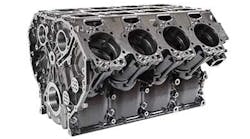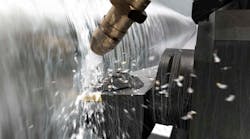Diagram shows how main force vector aligns with strongest insert section in tangential milling cutter.
In heavy slab milling, hogging and scarfing, the specter of sudden tool failure can hinder throughput as much as removal rate. Scale, uneven surfaces, entry impact loads –all can snap off the cutting edge, leading to tool wrecks, unscheduled stoppages and rising scrap rates. The same risks arise in small-scale roughing, too. That’s why you it’s not uncommon for production engineers to ease way back on speeds and feeds for work like this. They simply want to avoid sudden tool failure and its collateral damage.
“If I could really trust the tool to survive, I’d be running a lot faster,” is an all-too-common observation.
Dura-Bar solved precisely this problem on two-ton billets, debottlenecking the finishing operations at its continuous casting operation. Throughput improved 60% — enough to eliminate a second shift – and edge life doubled.
Similarly, a rough milling operation on huge castings at construction equipment OEM Terex doubled the feed rate and improved edge life 35 to 1.
Common thread
The common denominator in these various cases is a switch from conventional milling to tangential milling (TM), which makes cutters much stronger and heavy cuts more secure – even on older, well-used machines.
When inserts are oriented tangentially, more inserts can fit on a small cutter, distributing cutting forces more widely for smoother cut. Insert pockets don’t cut as deeply into the cutter body, which leaves more metal intact for a stronger cutting platform. The new Ingersoll 2-in. S-MAX tangential milling cutter (left) fits seven effective inserts in same circle as a conventional cutter (right), which fits just four. Note how little of the TM cutter body needs to be machined away to provide insert pockets on new cutter.
Why is tangential milling so well suited for this punishing duty? “The inserts lie flat along the pitch circle, not upright, which benefits tool life at least three ways,” explains Tom Noble, product manager at Ingersoll Cutting Tools, which pioneered the TM concept in the 1960s.
“First, the tangential orientation presents the insert’s strongest cross section to the main cutting vector. Second, TM inserts need shallower pockets, leaving more metal in the cutter body itself for greater strength. Third, for the same reason, more inserts can fit into the same size pitch circle, so chip loads can be distributed more evenly over more edges.” Figures 1 and 2 illustrate this idea.
At the other end of the size scale, brake manufacturer Akebono Brake Corp.debottlenecked a deceptively challenging rough milling job in an area no bigger than a poker chip. Since the milling is part of a synchronous operation on a high-volume part, the manufacturer’s chief gain was fewer line stoppages and longer tool life. And, Riviera Tool,a producer of transfer and progressive dies, dramatically increased throughput on both large mold blocks and small slots without having to worry about tool breakage or process security. “TM has definitely expanded into small-scale rough milling,” Noble says.
Started big
At first, tangential milling targeted flat scarfing work on high HP machines taking heavy passes on massive plates and castings. Cuts of 0.100-0.200 inches per pass, in 10-12 inch swaths are not uncommon. The smallest available cutter diameter was about 4 inches. Back in that era, moreover, the only available TM inserts were zero-rake squares nested in zero-rake cutter pockets. This tool geometry disqualified TM for everything but strictly flat work – no ramping allowed.
Dura-Bar debottlenecked this rough milling operation by switching to tangential milling. Ingersoll S-MAX cutter raised throughput by 60% and edge life by more than 2 to 1. The gain eliminated the cost of an extra shift and outsourcing to keep pace with orders.
Today by contrast, TM is paying off in smaller scale work as well. Akebono Brake roughs off just 0.010 cu. in. around the hose mounting area on a brake caliper. They do it with a two-inch S-MAX cutter, making them the first manufacturer to use the smallest TM cutter. Inserts have pos-pos geometry, helical cutting edge, and PVD coatings, all of which contribute to easier cleaving-type cutting action. The edges last 18 times longer than the previous conventional mill in that application. In fact, the first set of TM inserts lasted four months, versus the previous average of six days. Akebono was so pleased that it quickly applied the same TM cutter to four other small roughing jobs, and projects an $11,000 annual saving on insert purchases alone. At last report they are actively standardizing on the TM approach for small-area rough milling, including mild ramping, throughout their global operations.
Most TM practitioners, however, get into it to debottleneck heavy rough milling on big stuff — work that has been held back due to concerns over tool survival.
No more slowdowns
Originally, Dura Bar roughed its bar stock with a traditional 12-inch cutter equipped with zero rake inserts oriented radially. The goal is simply to make the bars flat, parallel and straight. Bars ranged from 4.5 to 21 inches on a side and 72 to 102 inches long. Stock removal ranged from 0.250 to 0.750 inch, always on scaly cast iron. The operation may require three to seven passes, which means multiple entries into the work and having to slow down the feed each time.
The changeover began when, during a regular plant walk-through, Ingersoll’s Mike Crabtree noticed the slowing-down at the beginning of every pass. Ingersoll had just added 45-degree lead angle cutters to their S-MAX tangential milling line, so he suggested a trial. “I believed that the combination of the tangential orientation and the 45-degree lead angle would enable the tool to enter the work at full speed,” said Crabtree. “The tangential orientation would create a stronger tool, while the lead angle would reduce the entry impact loads.”
The trial validated his theory, so then the next task was to optimize the settings. Where once Dura Bar machinists ran the operation at 220RPM, 10IPM, 0.300 DOC, now they feed at 17 IPM at a slower 170 RPM – and never slow down at the entry on each pass. Insert life has more than doubled as well. Not a single edge has ruptured at entry in more than two years.
Judging from the red hot chips, Terex’s rough milling operation now looks more like grinding. Ingersoll tangential face mill itself stays cool, but creates enough heat in the workpiece to soften the metal for freer cutting. It also generates uniform chips that clear on their own from the cutting area.
Factoring in savings
Terex’s main challenge was to mill 0.700 inches of the ends of tubular castings big enough to stand in – and do it on a “loose” older machine. The parts are destined to become transmission boxes on heavy construction cranes. Previously the operation took 3.5 hours and wrecked inserts during the cut, which forced a stoppage each time. Fugitive mist from the cutting fluid occasionally fogged the work area, making matters worse.
Now the operation, running dry, takes just 45 minutes and the tools last five times longer. The fog cleared, too. The 8-inch cutter feeds at 30 IPM at 0.100 in. depth of cut (DOC) and 600 RPM, up from 15 IPM with the same RPM and DOC as before.
And the process is secure. “The inserts never suddenly rupture or crack anymore, they just wear out gradually,” says Roberto Magallanes, Terex lead man. Again, based on success with this job, Terex has standardized on TM for all heavy flat rough milling.
“It runs reliably faster with edges lasting reliably longer – reliable enough for us to shelve a big capital equipment investment,” adds Jim Rice, operations manager. “It is the kind of improvement we can factor into budget planning.”
Tangential milling cutter takes roughing cut at Akebono. Retooling boosted edge life by 18 to 1, eliminated a vibration problem that had caused 4-5 line stoppages per shift in the past.
Since those early days of tangential milling back in the ‘60s, Ingersoll has steadily expanded their tangential tooling line – offering smaller diameters and improved insert geometries that allow more nonlinear toolpaths. Today, Ingersoll MAX tangential milling tools are available in more than 20 standard styles covering the diameter range 0.750 to 12 inches.
“We’re especially excited at TM’s success and potential in smaller parts and on low HP machines,” Tom Noble reports. “Inherent strength of the cutters coupled with freer machining geometries makes tangential machining the go-to solution for a much wider variety of rough milling work.”
Slabbing and slotting
One satisfied practitioner of TM milling for small-scale work is Riviera Tool Co. Over the past year, the Grand Rapids, MI, diemaker has switched to tangential milling for rough and finish slabbing work, and raised throughput more than 40%. Tool life rose as well, while power consumption dropped. Riviera has also changed over to tangential milling for the majority of small slotting work with the new 1-inch S-MAX tangential cutter, presently the smallest size available.
Slab milling is an everyday operation at Riviera Tool, which makes large dies for auto and truck bodies. Switching to tangential milling has sped up the operation 40% on average, extended tool life 30% and reduced machine power requirements. Riviera estimates saving more than $100,000 in machining costs within one year of standardizing on Ingersoll S-MAX tangential milling cutters for all rough and finish slab milling.
Riviera’s TM tool inventory covers the diameter range from 1 to 12 inches. They report saving about 20 hours slabbing every set of die shoes. “Tool life is up in both slabbing and slotting, and power consumption is down,” reports Frank Upton, Riviera machine manager. “The power meter that used to read 95% of machine capacity or higher now hovers nearer 80%. I’m sure the power reduction will also help our machines last years longer.”












